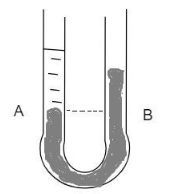
The liquids shown in fig. in the two arms are mercury (specific gravity$ = 13.6$ ) and water. If the difference of heights of the mercury columns is $2\,cm$ , find the height $h$ of the water column.

(A) $27\,cm$
(B) $30\,cm$
(C) $35\,cm$
(D) $44\,cm$

Answer
563.4k+ views
Hint:The points $A$ and $B$ are at the same level, hence the pressure of the liquids at the same medium is equal. Substitute the formula of the pressure in this relation and substitute the known values to find the answer for the height of the water in the tube.
Formula used:
The formula of the pressure is given by
$P = fgh$
Where $P$ is the pressure of the liquid, $f$ is the specific gravity of the liquid, $g$ is the acceleration due to gravity and the $h$ is the height of the liquid present in the manometer.
Complete step by step solution:
It is given that the
Specific gravity of the mercury $ = 13.6$
Height of the mercury is $2\,cm$
In general, the pressure at the same level in the same medium is the same.
Hence the pressure at a point $A$ must be equal to the pressure at the point $B$ .
Pressure at $A$ = Pressure at $B$
Substituting the formula of the pressure in the above step.
${f_w}gh = {f_m}gH$
Substituting the values of the specific gravity and the height of the mercury.
$h = 13.6 \times 2$
By performing the basic arithmetic operation in the above step, we get
$h = 27.2 \approx 27\,cm$
Hence the height of the water column in the manometer is $27\,cm$ .
Thus the option (A) is correct.
Note:In this question, the specific gravity of the water is substituted as one. In the manometer, when the positive pressure is given to one arm, then the liquid in the other arm moves up. This change or difference in height gives the pressure.
Formula used:
The formula of the pressure is given by
$P = fgh$
Where $P$ is the pressure of the liquid, $f$ is the specific gravity of the liquid, $g$ is the acceleration due to gravity and the $h$ is the height of the liquid present in the manometer.
Complete step by step solution:
It is given that the
Specific gravity of the mercury $ = 13.6$
Height of the mercury is $2\,cm$
In general, the pressure at the same level in the same medium is the same.
Hence the pressure at a point $A$ must be equal to the pressure at the point $B$ .
Pressure at $A$ = Pressure at $B$
Substituting the formula of the pressure in the above step.
${f_w}gh = {f_m}gH$
Substituting the values of the specific gravity and the height of the mercury.
$h = 13.6 \times 2$
By performing the basic arithmetic operation in the above step, we get
$h = 27.2 \approx 27\,cm$
Hence the height of the water column in the manometer is $27\,cm$ .
Thus the option (A) is correct.
Note:In this question, the specific gravity of the water is substituted as one. In the manometer, when the positive pressure is given to one arm, then the liquid in the other arm moves up. This change or difference in height gives the pressure.
Recently Updated Pages
Why are manures considered better than fertilizers class 11 biology CBSE

Find the coordinates of the midpoint of the line segment class 11 maths CBSE

Distinguish between static friction limiting friction class 11 physics CBSE

The Chairman of the constituent Assembly was A Jawaharlal class 11 social science CBSE

The first National Commission on Labour NCL submitted class 11 social science CBSE

Number of all subshell of n + l 7 is A 4 B 5 C 6 D class 11 chemistry CBSE

Trending doubts
What is meant by exothermic and endothermic reactions class 11 chemistry CBSE

10 examples of friction in our daily life

One Metric ton is equal to kg A 10000 B 1000 C 100 class 11 physics CBSE

1 Quintal is equal to a 110 kg b 10 kg c 100kg d 1000 class 11 physics CBSE

Difference Between Prokaryotic Cells and Eukaryotic Cells

What are Quantum numbers Explain the quantum number class 11 chemistry CBSE




